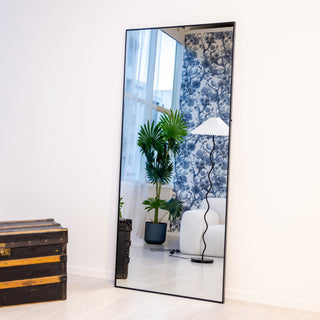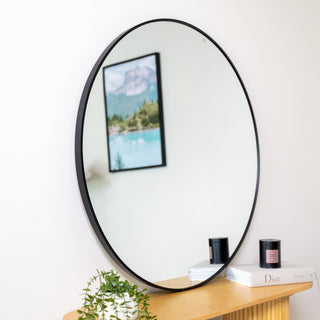Kia ora, dear readers! J here from C&F Creation.
Have you ever gazed into a mirror and wondered about its origins? Mirrors have a rich history dating back thousands of years, evolving from simple reflective surfaces to the high-quality full-length mirrors we offer today. Join me on a journey through time to discover how mirrors have transformed and the remarkable craftsmanship behind them.
Ancient Beginnings: Obsidian Mirrors (Around 8,000 B.C.)
The earliest known mirrors date back to around 8,000 B.C. in Anatolia (modern-day Turkey), where people used obsidian, a naturally occurring volcanic glass. By meticulously polishing this dark, glossy stone, they created the world's first handheld mirrors.
- Obsidian Mirrors: Heavy and rare, primarily used by the wealthy for decoration and personal grooming.
- Cultural Significance: Often associated with mystical properties, sometimes referred to as "black mirrors" used in ancient rituals.
Bronze and Metal Mirrors: Reflecting Advancements (2,900 B.C. - 200 B.C.)
Egypt and China: The Rise of Bronze Mirrors
Around 2,900 B.C., Egyptians and later the Chinese began crafting mirrors from polished metals like bronze and copper.
- Design: Typically small, round disks with handles made from wood, metal, or ivory.
- Usage: Accessible to more people but still a symbol of status and wealth.
The Lighthouse of Alexandria
In 280 B.C., the famed Lighthouse of Alexandria reportedly used a large curved metal mirror to project light from a fire, guiding ships safely at night.
- Innovation: Demonstrated the practical applications of mirrors in navigation and safety.
- Legacy: One of the Seven Wonders of the Ancient World, showcasing early engineering marvels.
Legendary Tales: Archimedes and the Burning Mirrors (212 B.C.)
The Greek mathematician Archimedes is said to have used mirrors to defend the city of Syracuse from Roman ships.
- The Myth: By arranging hexagonal mirrors to focus sunlight, he allegedly set enemy ships on fire.
- Modern Experiments: Shows like "MythBusters" have tested this theory with mixed results.
- Debate: While historically unconfirmed, it highlights the longstanding fascination with mirrors' potential.
Medieval Innovations: Mercury Mirrors and the Venetian Craft (15th - 16th Century)
Murano Glass Mirrors
In Renaissance Italy, particularly on the island of Murano in Venice, artisans began producing high-quality glass mirrors.
- Technique: Glass plates were coated with a reflective amalgam of tin and mercury.
- Exclusivity: Mirrors were luxury items, affordable only to the wealthy and nobility.
- Health Risks: Mercury, now known to be toxic, posed significant health hazards to craftsmen.
The Silvering Revolution: Modern Mirror Making Begins (1835)
German chemist Justus von Liebig revolutionised mirror production by developing the silvering process.
- Process: Applied a thin layer of metallic silver to glass using chemical reactions.
-
Benefits:
- Clarity: Improved reflective quality over previous methods.
- Safety: Eliminated the use of toxic mercury.
- Accessibility: Made mirrors more affordable and widespread.
Present Day: Aluminium-Coated Glass Mirrors
The Transition to Aluminium
Modern mirrors primarily use aluminium for the reflective coating.
- Vacuum Deposition: Aluminium is vaporised in a vacuum chamber and bonds directly to the cooled glass.
-
Advantages:
- Reflectivity: High reflection rates across ultraviolet and infrared ranges.
- Durability: Resistant to tarnishing when properly sealed.
Front Surface Mirrors
For precision applications, front surface mirrors have the reflective coating on the front.
- Uses: Scientific instruments, telescopes, and high-quality optics.
- Benefit: Eliminates secondary reflections from the glass itself, providing a true reflection without distortion.
Crafting Mirrors at C&F Creation
At C&F Creation, we combine time-honoured techniques with modern technology to produce exceptional full-length mirrors.
Our Process:
-
Selecting Premium Glass:
- Material: Ultra-clear float glass for minimal distortion.
- Quality Control: Rigorous inspection for imperfections.
-
Cutting and Shaping:
- Sizes Offered: From 160 cm x 60 cm up to 200 cm x 100 cm.
- Designs: From the sleek Facet Straight-Edged Mirror to the grand Grandeur Arched Mirror.
-
Applying the Reflective Coating:
- Aluminium Coating: Applied via advanced vacuum deposition.
- Uniformity: Ensures consistent reflection across the entire surface.
-
Protective Backing and Finishing:
- Safety Film: Shatter-resistant backing for added security.
- Sealing: Protective layers prevent oxidation and enhance durability.
-
Framing:
- Materials: High-quality aluminium alloy frames.
- Aesthetics and Support: Enhances visual appeal and structural integrity.
Why Understanding Mirror History Matters
- Appreciation of Craftsmanship: Recognising the evolution enhances respect for the artisanship involved.
- Informed Choices: Understanding materials and processes helps you select high-quality mirrors.
- Cultural Significance: Mirrors have played vital roles in art, science, and daily life throughout history.
Explore Our Collection
Discover the perfect mirror that combines historical craftsmanship with modern elegance.
Browse Our Full-Length Mirrors
Final Reflections
From polished obsidian stones to today's sophisticated aluminium-coated glass, mirrors have undergone a remarkable transformation. At C&F Creation, we're proud to be part of this enduring legacy, bringing you mirrors that reflect both your image and the rich history behind these everyday marvels.
Thank you for joining me on this journey through time. I hope it enriches your experience with our products and deepens your appreciation for the humble yet extraordinary mirror.
Ngā mihi nui,
J
Founder of C&F Creation















